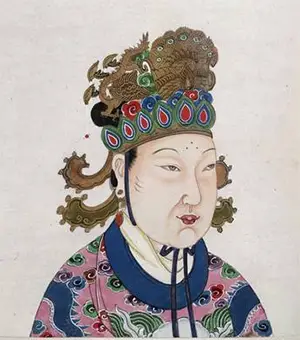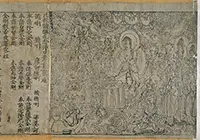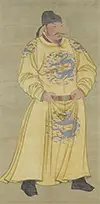China's Tang Dynasty
Li Yuan didn't let familial ties get in the way of his drive for power and deposed his cousin, Emperor Yang, the second and last of the Sui Dynasty in 618. The newly minted Emperor Gaozu declared the Tang Dynasty. Keeping the capital in Chang'an, Gaozu ruled for only a handful of years before giving way forcibly to his son Li Shimin, whose achievements led others to give him the title of "Great Khan." Taizong (left), as he Gaozu, the first Tang emperor, had introduced a land redistribution program in order to help peasant farmers better survive. Taizong continued this policy of his father's and expanded on its ideas not only with a further weakening of the aristocracy at the hands of the less well off but also with a doctrine of religious tolerance that allowed Buddhism, Christianity, and Islam to grow alongside the traditional practices of Confucianism and Taoism. 
Another practice that Taizong continued was the Sui Dynasty program of filling government posts by way of examinations, thus ensuring a higher level of intelligence throughout the civil service than might otherwise have been. At the same time, Tang China expanded both its foreign enemies list and its borders, sending armies along the Silk Road to points far and wide, claiming part of Mongolia among their conquests. The competent bureaucracy proved necessary to govern such a large stretch of geography. As well, Chinese traders sailed to India, the Persian Gulf, and to the Horn of Africa, further widening the cultural exchange and advancing practices in cartography. When Taizong died in 649, his ninth son, Li Zhi, succeeded him and took a new name, Gaozong. The new emperor had a wife, Lady Wang, but also had other women that he desired. One of these was Wu Zhao, who had been at the court of Emperor Taizong but had been sent away after that emperor's death. Gaozong had the young woman brought back to court and declared his favor for her. 
This emperor suffered from ill health but still reigned for more than three decades. When he suffered a stroke in 660, Wu Zhao took charge of most of the government. Gaozong tottered on until 683; when he died, his son Zhongzong became emperor. Both he and his brother Ruizong proved ineffective and found themselves forced from power by Wu Zhao, who, in 690, dispensed with all pretense and declared herself Empress Wu. The ascension of the empress brought with it a new dynasty, the Zhou, which lasted until Wu herself was deposed, in 704. During her reign, Empress Wu improved the education system, introduced government reforms, and improved agricultural practices. 
The return of the Tang Dynasty brought a succession of emperors, perhaps the most successful of whom was her grandson Xuanzong (left), who ruled for 44 years and oversaw the empire's greatest prosperity. Revenues were plentiful, prices were low, the people were generally happy, and the political situation was generally stable for a considerable period of time. Xuanzong ordered the reorganization of the military, freeing peasants from conscription and replacing them with a professional army. That prosperity did not last, and the next few imperial reigns suffered decline, punctuated by large-scale famine, economic and political uncertainty, and a number of armed rebellions. Significantly, Chinese armies suffered defeat at the hands of the Tibetan Empire at the 751 Battle of Talas. Also taking part in that titanic struggle was the Muslim army of the Abbasid Caliphate. The result was the end of the Tang westward expansion. Many historians say that Chinese prisoners taken as a result of that battle shared papermaking technology and techniques with their captors. Wuzong, ruling in the 840s, objected to the supremacy of Buddhism and cracked down on all religious institutions in a big way, ordering destroyed a large number of chapels and monasteries and turning hundreds of thousands of monks and nuns back into the general population. In the end, Xuanzong proved his own undoing, by falling in love with one of his ladies at court, Yang Guifei and giving her preference over the During the next few decades, China again suffered through tremendous upheaval. Historians often refer to the period between 907 and 960 as the Period of the Five Dynasties and Ten Kingdoms. 
Many historians refer to the Tang Dynasty as a golden era in Chinese history. Well-known inventions during this period included woodblock printing, enabling mass production of books of all kinds (including what is believed to be the earliest known book containing a date of printing, the Diamond Sutra (left)), and gunpowder, which was used for many years only for making fireworks. In the 8th Century, a Tang engineer, Yi Xing, created one of the world's first of what modern eyes would see as a mechanical clock. Other inventions credited to Tang engineers include air conditioning and gas stoves. The arts flourished to a large extent during the reign of the Tang emperors:
Not to be outdone, Emperor Xuanzong founded the Pear Garden, China's first acting and music academy, and encouraged the musical arts, which experienced a revival, along with the ancient dancing tradition. Tang China is also known for its leisure pursuits. Some people during these centuries were so well off that they had plenty of time for leisure. Tea drinking became fashionable in China at this time; The Classic of Tea, the first known treatise on the subject, dates to this period. A popular pastime among women of leisure was an early form of polo. |
|
Social Studies for Kids
copyright 2002–2024
David White



 called himself, killed his brothers and a few nephews in a move of power consolidation; once on the throne, he eventually had his father killed as well. Also once he became emperor, Taizong had his opponents executed. Balanced against this violent aspect of his reign were a series of state-building measures that made Chang'an the most populous city in the world and Tang China as expansive and powerful as was the mighty
called himself, killed his brothers and a few nephews in a move of power consolidation; once on the throne, he eventually had his father killed as well. Also once he became emperor, Taizong had his opponents executed. Balanced against this violent aspect of his reign were a series of state-building measures that made Chang'an the most populous city in the world and Tang China as expansive and powerful as was the mighty  affairs of state. The emperor appointed many of his lady love's family members to important positions in the government–reversing the trend that had sustained a competent governmental bureaucracy throughout the reigns of previous Tang rulers–and then ignored his royal duties, in favor of spending time with her, so much that a northern warlord named An Lushan led an invasion of Chang'an that seized the government and forced the emperor to run for his life. He fled westward, to Sichuan, and consolidated his power. By that time, the imperial army had had enough of Yang Guifei and refused to follow the emperor's orders unless she was dealt with; Xuanzong kept his throne by ordering his lady love killed (and their story was told in a later popular work, Song of the Everlasting Sorrow), but his inattention had brought on a rebellion that failed in the short term but, in the long run, succeeded in weakening the Tang Dynasty enough to shrink the imperial borders and give credence to a number of palace intrigues. These cut-and-thrust military and political maneuvers resulted in a number of short-term emperors and enough chaos that an 11-year-old found himself on the throne in 904. This last Tang emperor, named Zi, held onto power (in reality ruling through regents) for three years and then met his death at the hands of the warlord Zhu Wen, who proclaimed himself the new imperial ruler.
affairs of state. The emperor appointed many of his lady love's family members to important positions in the government–reversing the trend that had sustained a competent governmental bureaucracy throughout the reigns of previous Tang rulers–and then ignored his royal duties, in favor of spending time with her, so much that a northern warlord named An Lushan led an invasion of Chang'an that seized the government and forced the emperor to run for his life. He fled westward, to Sichuan, and consolidated his power. By that time, the imperial army had had enough of Yang Guifei and refused to follow the emperor's orders unless she was dealt with; Xuanzong kept his throne by ordering his lady love killed (and their story was told in a later popular work, Song of the Everlasting Sorrow), but his inattention had brought on a rebellion that failed in the short term but, in the long run, succeeded in weakening the Tang Dynasty enough to shrink the imperial borders and give credence to a number of palace intrigues. These cut-and-thrust military and political maneuvers resulted in a number of short-term emperors and enough chaos that an 11-year-old found himself on the throne in 904. This last Tang emperor, named Zi, held onto power (in reality ruling through regents) for three years and then met his death at the hands of the warlord Zhu Wen, who proclaimed himself the new imperial ruler. Poetry rose to prominence during the Tang years, and some of China's greatest poets lived during this time: Du Fu, Li Bai (right), Li Po, and Wang Wei. (The one glaring exception was the slaughtering of thousands of poets by the usurping warlord Huang Chao, in the late 9th Century, in response to one poem critical of him.) Overall, nearly 50,000 poems from the hands of 2,000 poets survive from the Tang period.
Poetry rose to prominence during the Tang years, and some of China's greatest poets lived during this time: Du Fu, Li Bai (right), Li Po, and Wang Wei. (The one glaring exception was the slaughtering of thousands of poets by the usurping warlord Huang Chao, in the late 9th Century, in response to one poem critical of him.) Overall, nearly 50,000 poems from the hands of 2,000 poets survive from the Tang period.
